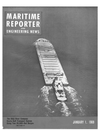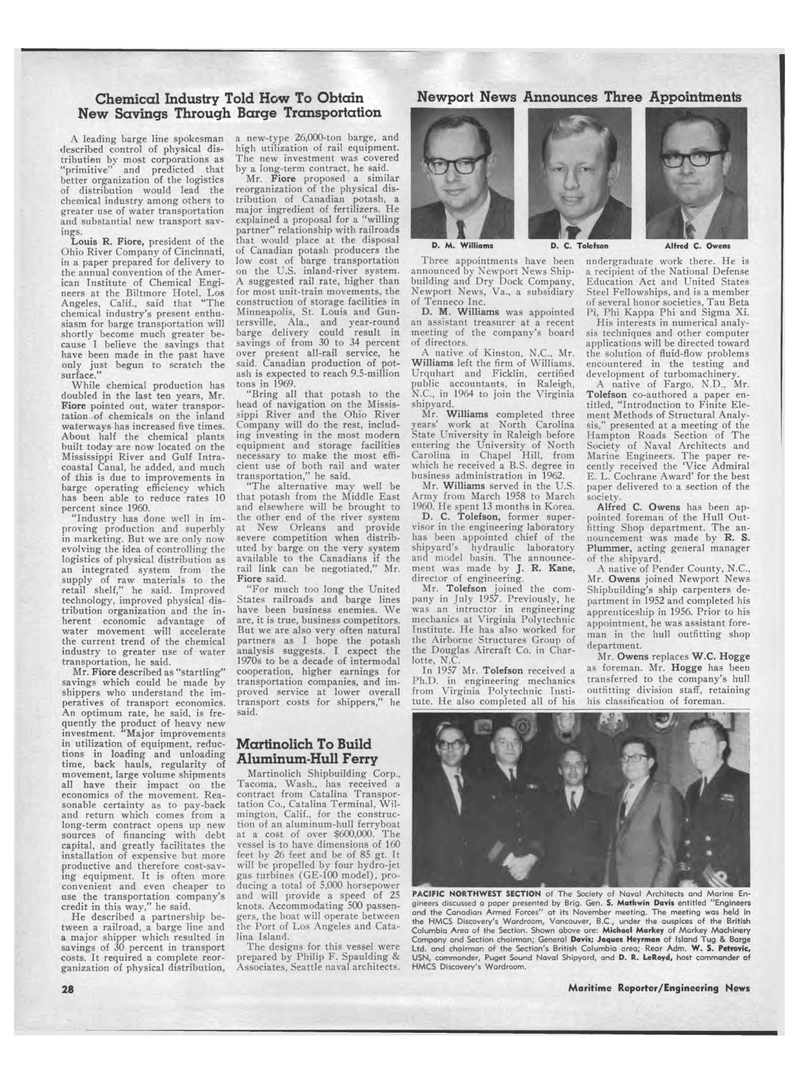
Page 30: of Maritime Reporter Magazine (January 1969)
Read this page in Pdf, Flash or Html5 edition of January 1969 Maritime Reporter Magazine
Chemical Industry Told How To Obtain New Savings Through Barge Transportation Newport News Announces Three Appointments A leading barge line spokesman described control of physical dis-tribution by most corporations as "primitive" and predicted that better organization of the logistics of distribution would lead the chemical industry among others to greater use of water transportation and substantial new transport sav-ings. Louis R. Fiore, president of the Ohio River Company of Cincinnati, in a paper prepared for delivery to the annual convention of the Amer-ican Institute of Chemical Engi-neers at the Biltmore Hotel, Los Angeles, Calif., said that "The chemical industry's present enthu-siasm for barge transportation will shortly become much greater be-cause I believe the savings that have been made in the past have only just begun to scratch the surface." While chemical production has doubled in the last ten years, Mr. Fiore pointed out, water transpor-tation of chemicals on the inland waterways has increased five times. About half the chemical plants built today are now located on the Mississippi River and Gulf Intra-coastal Canal, he added, and much of this is due to improvements in barge operating efficiency which has been able to reduce rates 10 percent since 1960. "Industry has done well in im-proving production and superbly in marketing. But we are only now evolving the idea of controlling the logistics of physical distribution as an integrated system from the supply of raw materials to the retail shelf," he said. Improved technology, improved physical dis-tribution organization and the in-herent economic advantage of water movement will accelerate the current trend of the chemical industry to greater use of water transportation, he said. Mr. Fiore described as "startling" savings which could be made by shippers who understand the im-peratives of transport economics. An optimum rate, he said, is fre-quently the product of heavy new investment. "Major improvements in utilization of equipment, reduc-tions in loading and unloading time, back hauls, regularity of movement, large volume shipments all have their impact on the economics of the movement. Rea-sonable certainty as to pay-back and return which comes from a long-term contract opens up new sources of financing with debt capital, and greatly facilitates the installation of expensive but more productive and therefore cost-sav-ing equipment. It is often more convenient and even cheaper to use the transportation company's credit in this way," he said. He described a partnership be-tween a railroad, a barge line and a major shipper which resulted in savings of 30 percent in transport costs. It required a complete reor-ganization of physical distribution, a new-type 26,000-ton barge, and high utilization of rail equipment. The new investment was covered by a long-term contract, he said. Mr. Fiore proposed a similar reorganization of the physical dis-tribution of Canadian potash, a major ingredient of fertilizers. He explained a proposal for a "willing partner" relationship with railroads that would place at the disposal of Canadian potash producers the low cost of barge transportation on the U.S. inland-river system. A suggested rail rate, higher than for most unit-train movements, the construction of storage facilities in Minneapolis, St. Louis and Gun-tersville, Ala., and year-round barge delivery could result in savings of from 30 to 34 percent over present all-rail service, he said. Canadian production of pot-ash is expected to reach 9.5-million tons in 1969. "Bring all that potash to the head of navigation on the Missis-sippi River and the Ohio River Company will do the rest, includ-ing investing in the most modern equipment and storage facilities necessary to make the most effi-cient use of both rail and water transportation," he said. "The alternative may well be that potash from the Middle East and elsewhere will be brought to the other end of the river system at New Orleans and provide severe competition when distrib-uted by barge on the very system available to the Canadians if the rail link can be negotiated," Mr. Fiore said. "For much too long the United States railroads and barge lines have been business enemies. We are, it is true, business competitors. But we are also very often natural partners as I hope the potash analysis suggests. I expect the 1970s to be a decade of intermodal cooperation, higher earnings for transportation companies, and im-proved service at lower overall transport costs for shippers," he said. Martinolich To Build Aluminum-Hull Ferry Martinolich Shipbuilding Corp., Tacoma, Wash., has received a contract from Catalina Transpor-tation Co., Catalina Terminal, Wil-mington, Calif., for the construc-tion of an aluminum-hull ferryboat at a cost of over $600,000. The vessel is to have dimensions of 160 feet by 26 feet and be of 85 gt. It will be propelled by four hydro-jet gas turbines (GE-100 model), pro-ducing a total of 5,000 horsepower and will provide a speed of 25 knots. Accommodating 500 passen-gers, the boat will operate between the Port of Los Angeles and Cata-lina Island. The designs for this vessel were prepared by Philip F. Spaulding & Associates, Seattle naval architects. D. M. Williams D. C. Tolefson Alfred C. Owens Three appointments have been announced by Newport News Ship-building and Dry Dock Company, Newport News, Va., a subsidiary of Tenneco Inc. D. M. Williams was appointed an assistant treasurer at a recent meeting of the company's board of directors. A native of Kinston. N.C.. Mr. Williams left the firm of Williams, Urquhart and Ficklin, certified public accountants, in Raleigh, N.C., in 1964 to join the Virginia shipyard. Mr. Williams completed three years' work at North Carolina State University in Raleigh before entering the University of North Carolina in Chapel Hill, from which he received a B.S. degree in business administration in 1962. Mr. Williams served in the U.S. Army from March 1958 to March 1960. He spent 13 months in Korea. D. C. Tolefson, former super-visor in the engineering laboratory has been appointed chief of the shipyard's hydraulic laboratory and model basin. The announce-ment was made by J. R. Kane, director of engineering. Mr. Tolefson joined the com-pany in July 1957. Previously, he was an intructor in engineering mechanics at Virginia Polytechnic Institute. He has also worked for the Airborne Structures Group of the Douglas Aircraft Co. in Char-lotte, N.C. In 1957 Mr. Tolefson received a Ph.D. in engineering mechanics from Virginia Polytechnic Insti-tute. He also completed all of his undergraduate work there. He is a recipient of the National Defense Education Act and United States Steel Fellowships, and is a member of several honor societies, Tau Beta Pi, Phi Kappa Phi and Sigma Xi. His interests in numerical analy-sis techniques and other computer applications will be directed toward the solution of fluid-flow problems encountered in the testing and development of turbomachinery. A native of Fargo, N.D., Mr. Tolefson co-authored a paper en-titled, "Introduction to Finite Ele-ment Methods of Structural Analy-sis," presented at a meeting of the Hampton Roads Section of The Society of Naval Architects and Marine Engineers. The paper re-cently received the 'Vice Admiral E. L. Cochrane Award' for the best paper delivered to a section of the society. Alfred C. Owens has been ap-pointed foreman of the Hull Out-fitting Shop department. The an-nouncement was made by R. S. Plummer, acting general manager of the shipyard. A native of Pender County, N.C., Mr. Owens joined Newport News Shipbuilding's ship carpenters de-partment in 1952 and completed his apprenticeship in 1956. Prior to his appointment, he was assistant fore-man in the hull outfitting shop department. Mr. Owens replaces W.C. Hogge as foreman. Mr. Hogge has been transferred to the company's hull outfitting division staff, retaining his classification of foreman. PACIFIC NORTHWEST SECTION of The Society of Naval Architects and Marine En-gineers discussed a paper presented by Brig. Gen. S. Mathwin Davis entitled "Engineers and the Canadian Armed Forces" at its November meeting. The meeting was held in the HMCS Discovery's Wardroom, Vancouver, B.C., under the auspices of the British Columbia Area of the Section. Shown above are: Michael Markey of Markey Machinery Company and Section chairman; General Davis; Jaques Heyrman of Island Tug & Barge Ltd. and chairman of the Section's British Columbia area; Rear Adm. W. S. Petrovic, USN, commander, Puget Sound Naval Shipyard, and D. R. LeRoyd, host commander of HMCS Discovery's Wardroom. 28 Maritime Reporter/Engineering News

 29
29

 31
31
